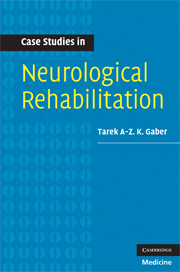2 - The rehabilitation unit
from Part I - Clinical rehabilitation
Published online by Cambridge University Press: 13 August 2009
Summary
Most neurological rehabilitation units admit patients following acute neurological damage such as brain injury, spinal injury or stroke. The standard practice is to admit patients once they are medically stable, assuming that the patient has good potential for rehabilitation. The necessity of medical stability as an essential requirement for accepting the patient for an inpatient rehabilitation programme is not only to ensure that the patient is able to tolerate therapy but also because of the relative inexperience of the rehabilitation team in dealing with acute and active complex medical issues. Rehabilitation units will certainly differ in their staffing, location and philosophy, with some units geared more towards accepting patients early on after the neurological insult and others accepting patients in after the acute stage. In the acute stage following a neurological insult such as a traumatic head injury, encephalitis or subarachnoid haemorrhage, rehabilitation needs are unique and involve mainly issues such as tracheostomy management, maintaining the range of movements in joints, management of early seizures or managing cognitive or behavioural impairments during the period of post-traumatic amnesia. It is essential that a service dealing with this stage has the expertise to manage such acute stage problems, sufficient staff, an intensity of medical input and a location that ensures immediate access to specialist medical and surgical support. A unit accepting patients at a later stage of their rehabilitation may need less intense medical input but should have different facilities such as designated large therapy areas, occupational therapy kitchens or small flats for independent living to evaluate patients before discharge.
- Type
- Chapter
- Information
- Case Studies in Neurological Rehabilitation , pp. 6 - 8Publisher: Cambridge University PressPrint publication year: 2008

